Departure Date: April 19 - 26, 2025
Compiled By: Erik Bruhnke
Trip Leaders: Erik Bruhnke, Brian Gibbons
Toll Free: 800.328.8368
Phone: 512.328.5221
High Island Migration 4/19/2025-4/26/2025

https://ebird.org/tripreport/354500
Our High Island Migration tour was an exciting whirlwind of incredible migration and wonderful local specialties alike. Every day was a birding treasure hunt, as we explored different environments with different birding possibilities, changing day by day. We read the winds and weather patterns, planning our daily route to best coincide with the arrival of birds. What a fun and memorable adventure this was!
On our first morning we had a pre-sunrise breakfast, welcomed to the van by charismatic Great-tailed Grackles in the parking lot. For as common as they are, it was fun to be in the presence of these chatty birds every day of the tour. We set our sights on birding the Pineywoods north of Houston, and the specialties delighted us. A casual walk through the towering pine trees had us viewing three fabulous Red-cockaded Woodpeckers, a big target of our morning there! Impressive views of this species were enjoyed through the scopes. It was sad to know that this wonderful species is threatened, and we felt honored to have such great views of this awesome species. Cute squeaks were heard overhead, as Brown-headed Nuthatches fed along the pine branches. The Pineywoods visit was a lively success with many other bird species enjoyed.
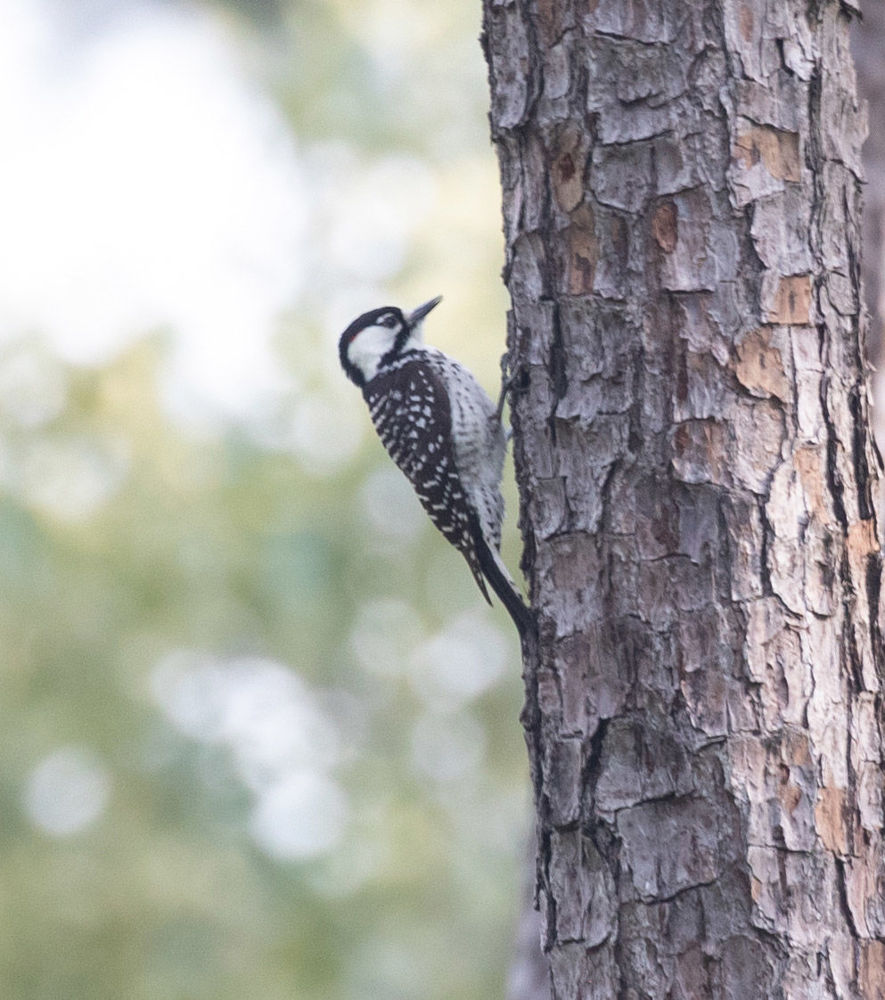
Beautiful Red-cockaded Woodpecker in the Pineywoods © Erik Bruhnke
Later that morning, we birded some areas of the Sam Houston National Forest. Hooded Warblers sang their beautiful songs through the understory. Pine Warblers trilled far overhead. We came across two beautiful and uncommon Swainson’s Warblers along our casual forest roadside walks. It was a treat to bird through these southeastern pine forests. After a tasty lunch we enjoyed impromptu views of Fish Crow in a parking lot. Throughout the afternoon, highlights included scoping out six Buff-breasted Sandpipers among sod fields. We also birded along rice fields south of Winnie. We scored some amazing sights on our first afternoon in the area, including six Hudsonian Godwits, 85 Whimbrels, and more. A very pale Krider’s Red-tailed Hawk was seen perching and flying around, as were a White-tailed Hawk, Swainson’s Hawk, and Crested Caracara. Sassy Loggerhead Shrikes were also observed, on high alert for their next fast-flying meal. The highlights kept on coming until returning to Winnie for our first night in the area.
The next morning we had our sights set on the Jocelyn Nungaray National Wildlife Refuge (formerly known as Anahuac National Wildlife Refuge), but not before birding some fields en route. It was fun to soak up the birding both on the way to the refuge and, of course, within the refuge itself. We found ourselves saying, “there are simply too many cool birding moments” on the way to the refuge, visiting field after field. We found several areas chockfull of shorebirds, including both dowitcher species, Pectoral Sandpipers, and others (10 shorebird species altogether). Point-blank views of a chatty Sedge Wren were special! Upon arriving at the refuge, we were greeted by Orchard Orioles whistling in the parking area, a variety of swallows flying around, and the distant chatter of Boat-tailed Grackles. Our time around the wildlife drive was exciting in both rain and shine. Hopping from viewing area to viewing area, we enjoyed comparison of both Black-bellied and Fulvous whistling-ducks, each beautiful in their own way. American Alligators of various ages rested along the nearby mudflats. Common Gallinules strutted along the water's surface while their less common cousin, the Purple Gallinules, fed more secretly while still offering views. Among a wild and numerous kaleidoscope of shorebirds, we found two uncommon White-rumped Sandpipers, each in full breeding plumage. Gull-billed Terns fed over the saltmarsh environments, and a Black Tern was picked out among the many Forster’s Terns. Dozens of White-faced Ibis were seen feeding among the saltgrass, and later on we found two less common Glossy Ibis among the mudflats. A sneaky and beautiful Least Bittern came into view. There were just so many birds to enjoy! Adorable baby Barn Owls were seen at midday, swaying together and analyzing us among the little nook and cranny they were being raised within, and all of this was enjoyed before a fun picnic in the field.
On our first afternoon at High Island we hit a birding jackpot of 18 warbler species and more! Many of the warblers were seen among food-rich mulberry trees and also at the nearby Boy Scout Woods ponds and drip areas. Among so many exciting warbler highlights was a female Cape May Warbler. This warbler species is quite rare in Texas, often migrating slightly east of the East Texas landscape, and is a considerable rarity for the tour. An Indigo Bunting fed near three Painted Buntings, while both Summer and Scarlet tanagers gorged themselves on berries. A late-lingering White-throated Sparrow was seen in a tree, and three thrush species were noted, which included Gray-cheeked, Swainson’s, and Wood! Tasty and festive bayou dinner fixins at Tia Juanita’s complemented a great day of birding.
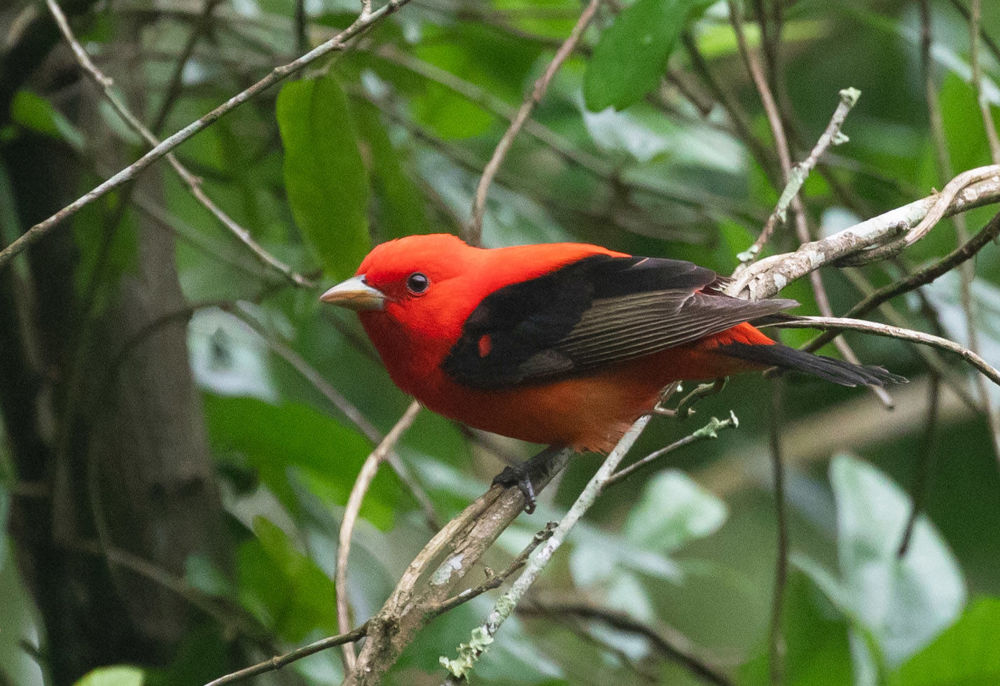
Handsome male Scarlet Tanager © Erik Bruhnke
The next day we had our sights set on the beach birding scene. Rollover Pass was a treat to the senses, as the highlights stacked up one after the other. A super-close Clapper Rail strutted right in front of us among the saltgrass. We were very surprised to see a visibly migrating Northern Cardinal fly past us along the beach, not expected among the vast dune environment. A temporarily exposed tidal island offered scope views of a large gathering of Brown Pelicans with one American White Pelican. Nonstop studying opportunities of a kaleidoscope of terns, gulls, and wading birds ensued. Black Skimmers rested their heavy beaks on the sand in their own comical way. Before we left, a Marbled Godwit was seen in the saltgrass while Brian picked out a distant Black Scoter, a rarity for the area. A little later on we explored the Bolivar Flats area, going for a walk down the beach, which brought forth wonderful views of hundreds of American Avocets, Willets, Ruddy Turnstones, and wave-chasing Sanderlings to name a few species. A few Roseate Spoonbills flew by, and both white and dark morph Reddish Egrets were seen well. During our walk we saw six Piping Plovers and three Wilson’s Plovers! We did a “picnic-with-the-plovers” afterwards in a designated picnicking area, where we saw both American and Black-bellied plovers while eating. Before our day ended, we had a fabulous time visiting the Smith Oaks sanctuary, taking time to enjoy the Roseate Spoonbills, herons, egrets, and cormorants nesting there. The bold colors of the Roseate Spoonbills were especially eye-catching. We enjoyed views of the large Swamp Rabbits, as well as Red-eared Sliders and American Alligators.
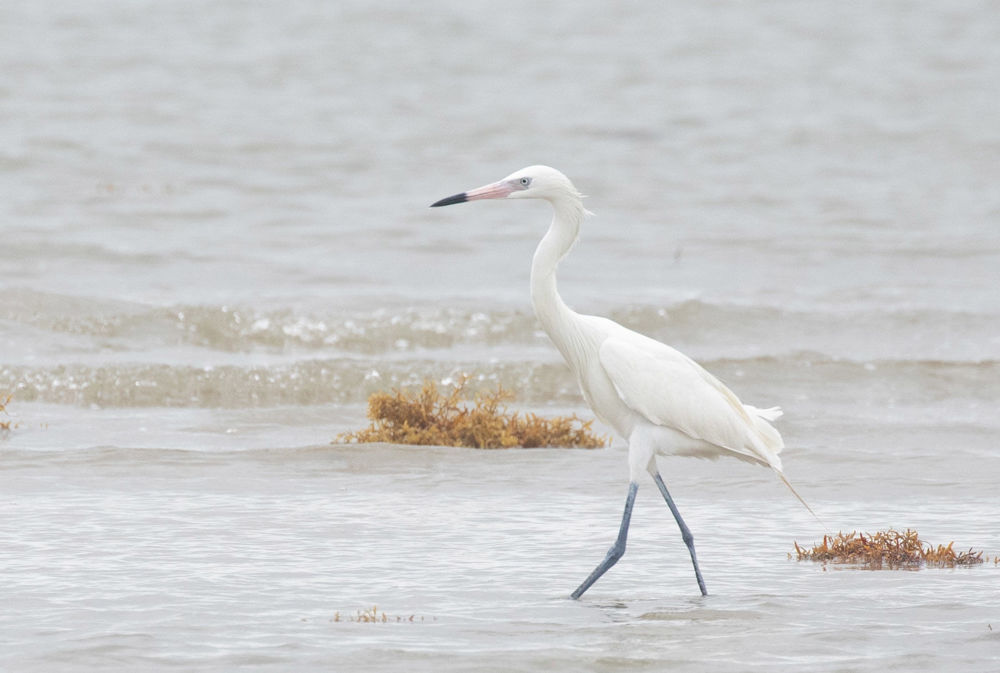
Reddish Egret fishing along the shallow waters © Erik Bruhnke
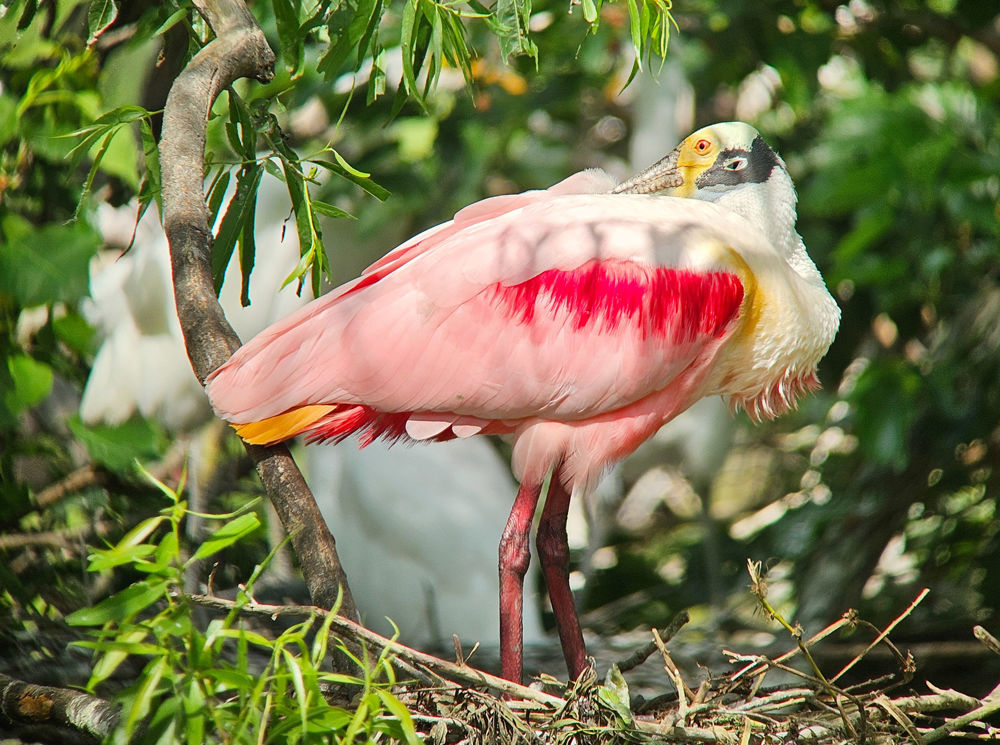
Nesting Roseate Spoonbill © Erik Bruhnke
The next morning we made our way in the direction of Sabine Woods. Before birding the legendary woods we enjoyed the wild sense-of-place of birding among some vast saltmarsh habitat, with no fewer than nine Seaside Sparrows singing and flying around their unique home-sweet-home. Throughout the morning we saw nine of these incredible habitat specialists, giving their eerie and sharp, shrilled songs. Boat-tailed Grackles squawked as neighboring ambience. Marsh Wrens cackled, too, among seven species of wading birds. There was so much going on, and our day was just beginning. A visit to Sabine Woods brought forth views of Prothonotary Warbler, Red-bellied Woodpecker, a flyby Peregrine Falcon, and more. A midday visit at Sea Rim State Park was thrilling, as we watched hundreds of American Avocets feeding together, reflecting on what Victor Emanuel called the “Avocet Dance.” We took moments to reflect and appreciate all that was happening right in front of us. It was beautiful. Soothing. Mesmerizing. Nesting Wilson’s Plovers were seen, and we were treated to some surreal comparison moments of Greater and Lesser yellowlegs feeding together, right next to each other for minutes on end (the nearby comparison doesn’t happen very often). Midday rain couldn’t have happened at a more opportune time, nearing the end of our lunch picnic, with the “Yucatan Express” of migration arriving more by the minute. On this tour, midday or early afternoon rain is what can really bring the birds into the area. On our way to Sabine Woods again we found a flock of thirty Bobolinks, usually a very uncommon species for the timing of this tour. Upon arrival at Sabine Woods we found ourselves looking at ten different species of warblers, both Gray-cheeked and Swainson’s thrushes, no fewer than ten Rose-breasted Grosbeaks, and more. It was a fun afternoon, and it was hard to pull away for our fantastic dinner that followed.
The next day we birded locally throughout the High Island area again, and what a fun day it was. The birds present had changed from over the past few days. The rookery at Smith Oaks was fabulous as ever, too, as one visit during a tour is never enough. A recent wave of cuckoos had arrived, as we saw four Yellow-billed Cuckoos and one Black-billed Cuckoo throughout the day. Wood Thrushes sang and hopped among the forest floor. We were very surprised to hear a Pileated Woodpecker calling from Smith Oaks (this is a super-rare species for the High Island area, not on the radar for the immediate High Island area). A flashy Blackburnian Warbler sang throughout the branches as both a Painted and several Indigo buntings worked their way throughout the more open areas, on the edges of the woods. There were too many birds to cherish and enjoy. We had some great moments watching an Ovenbird bathe in one of the nearby drips.
Our last day of this tour always comes too soon. We made our way into the Pineywoods to mix up the birds we were seeing throughout the trip, and what a special day it was! We scored some fantastic views of Red-headed Woodpecker and the dapper Prairie Warbler. During our birding trek back to Houston, we enjoyed one more picnic in the field, this time complemented with truly memorable experiences with kettles of Mississippi Kites, two Swallow-tailed Kites, and up-close views of an adorable Northern Mockingbird fledgling that bounced around the nearby grass. Our last birding stop had us birding along a waterway, where we scored views of a Limpkin! It was fun to watch this cool bird search the waters for Channeled Apple Snails. This tropical species is not typically on the radar for this tour. What a finale for an exciting tour all-round. Throughout our trip we enjoyed 200 species of birds, in addition to an exciting array of beautiful reptiles and amphibians, Hermit Crabs along a jetty, several mammals, butterflies, and more. What a thrill. I am already looking forward to next year’s High Island adventure!
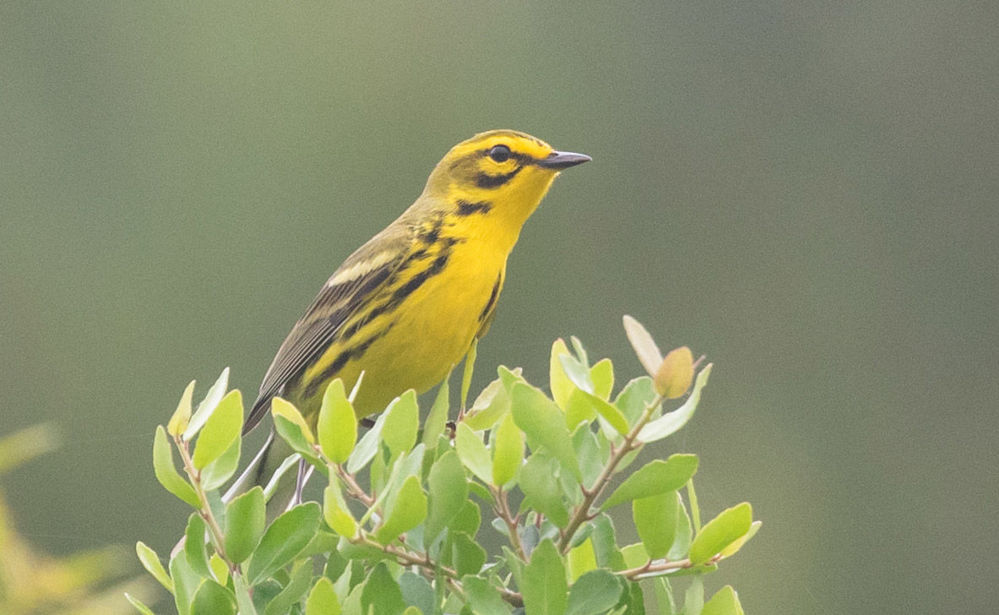
Prairie Warbler on his territory © Erik Bruhnke
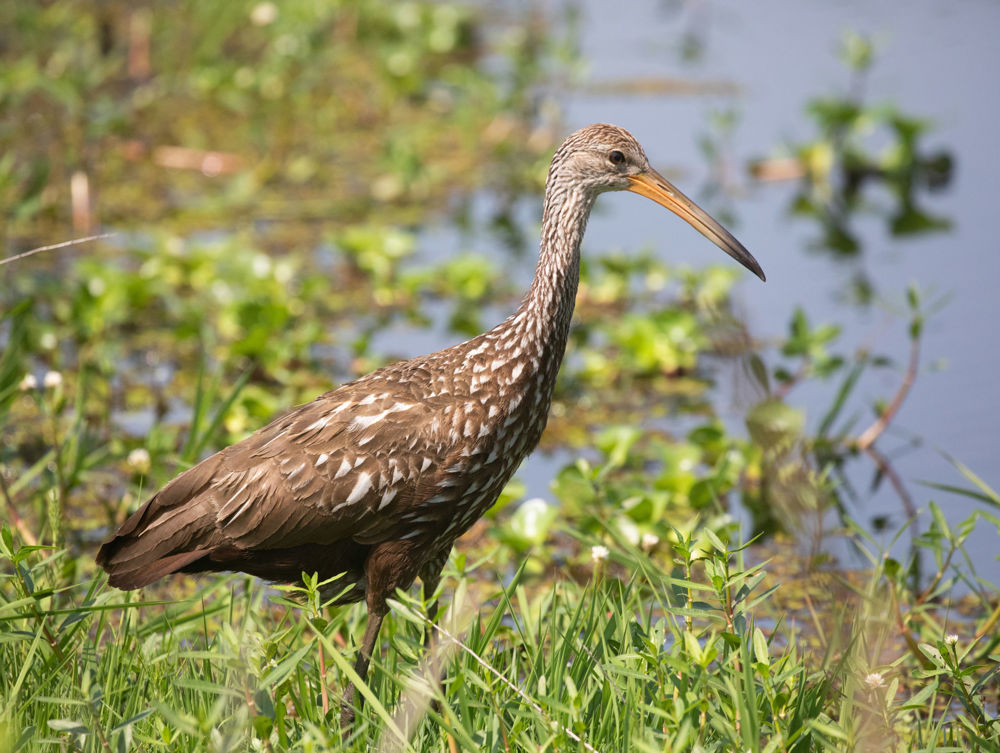
Limpkin. What a crazy treat at the end of our tour! © Erik Bruhnke
A complete list of the birds recorded on our tour can be found at: https://ebird.org/tripreport/354500
Our 50th Anniversary Celebration will be held on the Upper Texas Coast, April 19-24, 2026!

